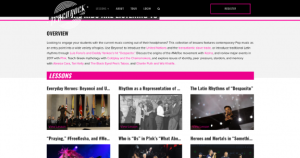General Interest
Back to Top
|
 |
|
 |
|
The New Canon: What's the most influential book of the past 20 years?
|
Language Arts |
|
Those who relish a thought-provoking, intellectual read should check out this article from The Chronicle of Higher Education, which compiles 21 responses from a range of scholars to the question "What's the most influential book of the past 20 years?" Respondents were asked "to select books -- academic or not, but written by scholars -- from within or outside their own fields," and their choices and explanations are presented here. For example, Leon Botstein, the president of Bard College, chose Arthur C. Danto's What Art Is, saying that, "Both art and philosophy have become increasingly marginal in the life of the university. Reading Danto reminds us that art and the critical consideration of the aesthetic ought not remain the poor stepchildren of the academy." In another example, Deborah Tannen, a history professor at Georgetown University, chose Robert Putnam's Bowling Alone: The Collapse and Revival of American Community. As Tannen points out, "Even people who didn't read the book's 500-plus pages through to the end -- or didn't read it at all -- are aware of its thesis. That's what influence is all about." [JDC] |
|





|
|
 |
|
Nieman Storyboard
|
Language Arts |
|
Aspiring writers and readers who love narrative journalism and nonfiction may particularly appreciate Nieman Storyboard, a publication of the Nieman Foundation for Journalism at Harvard University. This resource "showcases exceptional narrative journalism and explores the future of nonfiction storytelling," offering readers a unique view into great journalism and how it came into being. Nieman Storyboard features a number of regular columns, such as Why's This So Good?, which recently delved into Lizzie Johnson's reporting on the Camp Fire for the San Francisco Chronicle, and Annotation Tuesday!, which gives readers an inside peek into the journalistic process through questions and answers with a story's writer or editor alongside the finished piece. In addition to these and other regular sections, Nieman Storyboard "also features interviews with writers, coverage of literary conferences and events, and posts on narrative technique from veteran storytellers." Nieman Storyboard is edited by Jacqui Banaszynski, a Pulitzer-winning journalist and faculty fellow at the Poynter Institute. Interested readers can subscribe to receive weekly updates via email or RSS feed. [JDC] |
|





|
|
 |
|
Ohio Is Still a Piano
|
Social studies |
|
Readers interested in curious cartographies may enjoy this unusual interactive map of Ohio created by professional cartographer Andy Woodruff. While the map's appearance is fairly conventional, what sets it apart is that Woodruff, upon realizing that Ohio has 88 counties, assigned each county to correspond to one of a piano's 88 keys based on census data, thus turning Ohio into a cartographic musical instrument of sorts. Users can choose a census attribute, such as population per square mile or percent renter-occupied units, then "play" the map by mousing over the counties. Other options include playing a route between two cities, all the counties as a chromatic scale, or the song "The Entertainer." This version is actually Woodruff's second iteration of this project, which had to be rebuilt in HTML and Javascript after Google Maps for Flash stopped working. Those interested in the back story of this map will find a link to Woodruff's initial version with additional commentary at the beginning of this blog post. It should be noted that using this map requires a desktop computer, as it will not work on mobile devices, and that headphones may be appropriate if exploring this map in public. [JDC] |
|





|
|
 |
|
The Language of Birds
|
Science |
|
Did you know that the British Library's vast collections also include a wide variety of wildlife sounds? In the web presentation The Language of Birds, recordings from the library's sound collections, along with photographs, accompany a series of accessibly-written articles that explore and illustrate why and how birds communicate. Here, interested readers can learn about birdsong and how it differs from bird calls, the physiology of birds' vocalizations and hearing, how birds learn to sing and mimic, and the non-vocal ways that birds use sound to communicate (such as a woodpecker's drumming). This presentation includes a total of 15 articles, as well as 53 sound recordings with accompanying images featuring songbirds such as the nightingale and chaffinch, as well as other species such as parrots, peacocks, and ruffed grouse. The Language of Birds was written by Jeffery Boswall, a natural history broadcaster with the BBC, and originally published in Proceedings of the Royal Institution. [JDC] |
|





|
|
 |
|
The Modern Art Notes Podcast
|
Arts |
|
Art experts and aficionados who have not already discovered The Modern Art Notes Podcast (MAN) have been missing out. Every week since 2011, this highly acclaimed podcast has been treating its listeners to in-depth interviews with artists, curators, historians, and conservators, generally in two segments per hour-long episode. As of this writing, the MAN Podcast has well over three hundred episodes in its archives. One recent episode, for example, features a conversation with artist Laurie Simmons about her current exhibition at the Modern Art Museum of Fort Worth, and with Allegra Pesenti, curator at the Hammer Museum in Los Angeles, discussing an exhibition of Victor Hugo's drawings. Each episode is accompanied by images and links to further information and the podcast's back-catalog is well worth exploring. The Pulitzer-winner art critic Sebastian Smee has called the MAN Podcast "one of the great archives of the art of our time." The MAN Podcast is hosted and produced by the award-winning art critic and historian Tyler Green. Listeners can subscribe via RSS, iTunes, Stitcher, and other podcast platforms, or tune in on its website. [JDC] |
|





|
|
 |
|
The D.C. Underground Atlas
|
Social studies |
|
Underground tunnels are a familiar feature in many of the world's major cities and they offer a fascinating lens through which to view their city's history, geography, and culture. One such city is Washington, D.C., which features an extensive tunnel system dating back to the mid-1800s. The D.C. Underground Atlas provides its visitors with an interactive digital guide to this tunnel system, much of which is physically inaccessible to the public. This series of engaging StoryMaps, accompanied by several articles and numerous photographs, allows visitors to virtually explore Washington, D.C.'s underground networks of transportation, utility, and pedestrian tunnels, and learn about their role in the city's history. The atlas' information was largely sourced from publicly available utility maps, newspaper archives, and government documents. The D.C. Underground Atlas was created in 2018 by Elliot Carter, an amateur cartographer who writes about D.C.'s hidden history for Atlas Obscura, and is supported by a grant from the DC Commission on the Arts and Humanities. [JDC] |
|





|
|


















